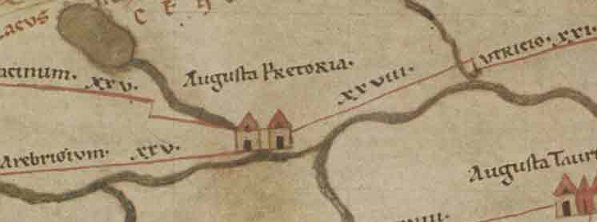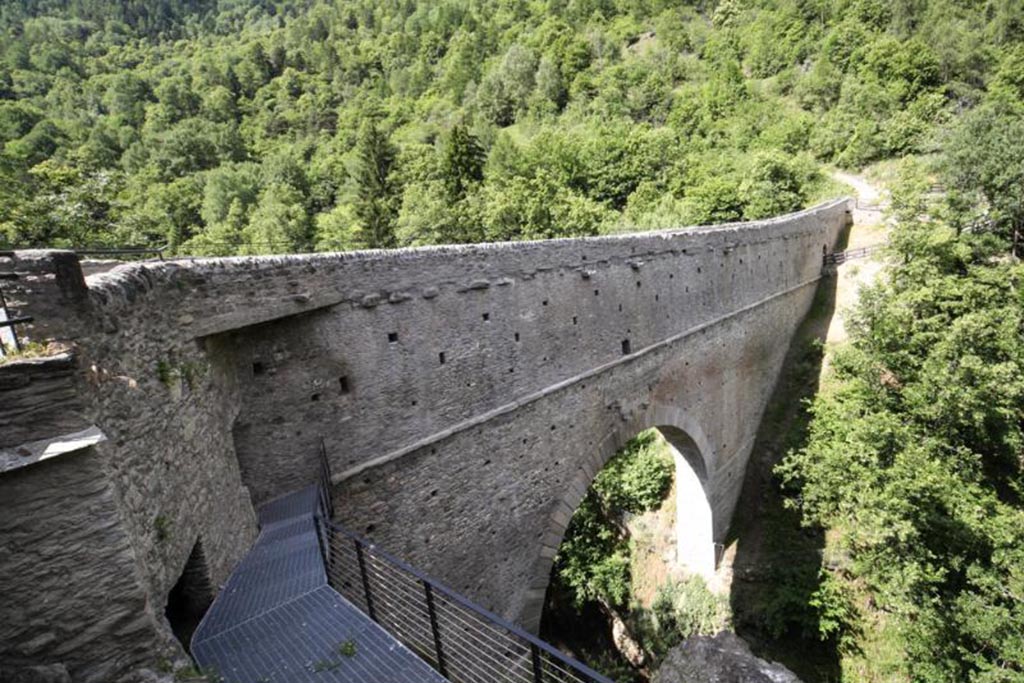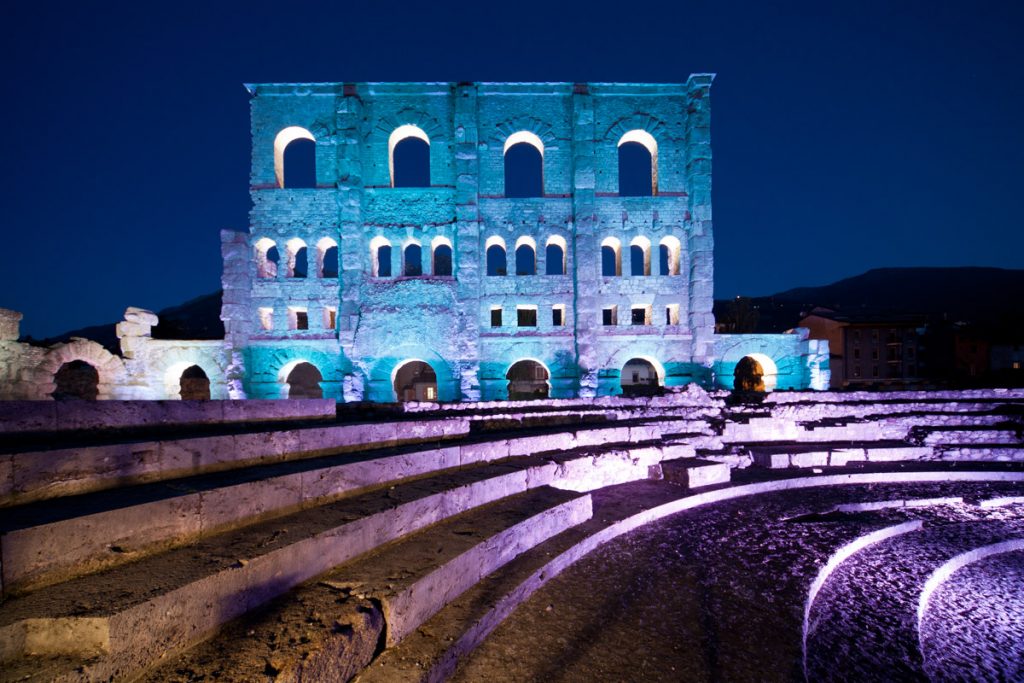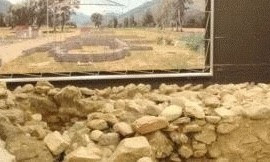Ancient Roman roads, a crumbling theatre, bridges and aqueducts, city walls and old crypts are all in evidence throughout the Aosta Valley. For further information click here.

THE VIA DELLE GALLIE CONSULAR ROAD
There were some primitive roads in Valle d’Aosta in the pre-Roman period. Originally trade paths through the Alps, remnants of some of these roads can still be seen today. The Gaul consular road, an undertaking of the highest engineering quality, was the first public work of the new conquerors, an indispensable infrastructure for their political and military expansion. Its archaeological ruins are still visible, as are the areas along it which were delegated as places of rest for people and animals. As well as the section between Donnas and Bard, the Pierre Taillée district preserves the most monumental part of the road, which cuts into the bare rock and is supported by cyclopean buildings.

PONDEL AQUEDUCT BRIDGE
This bridge dates back to 3 BC. and commemorates its promoter and owner, Caius Avillius Caimus. The structure included a 1m covered walkway with narrow windows on both walls, accessed at both ends with wooden doors. An open upper canal, with a stone slab base and water-proof walls, allowed the flow of water collected from springs on the left bank of the river. One theory links the aqueduct to the mining and processing of ferrous materials in the Cogne valley. Various modifications indicate a water collection function during the Post Classic period for village inhabitants.

PONT-SAINT-MARTIN ROMAN BRIDGE
The date of this bridge is uncertain: some say it was built around 120 BC, others say 25 BC. Wooden beam bearings dug into the live rock provided the necessary framework to build the stone arch, and some iron crowns were added at the end of the 19th century to strengthen the structure. The story goes that on returning to his diocese, the Bishop of Tours was obstructed by the Lys River, which had overflowed to block the only footpath. The devil offered to build a bridge in return for the soul of the first to cross. The saint accepted, then threw a piece of bread to the other side of the bridge, ensuring a starving dog was first to cross. The infuriated devil disappeared into the Lys with bolts of lighting and a sulphur stench, leaving the bridge to the local population.

ROMAN ARCH IN DONNAS
Consolare delle Gallie road was built to connect Rome to Valle del Rodano, and is at its most characteristic along the Donnas section where it cuts into the bare rock. The size of the excavation is emphasised by the rocky spur that was left behind, inside which this arch was dug. Measuring 4m thick and 4m high, in medieval times it was used as a gateway to the district, which was closed at night. You can still see tracks left on the road by the carriages, while a short distance after the arch you can see the milestones with the number 36 displaying the distance in miles from Donnas to Aosta.

AUGUSTUS ARCH
Immediately after Buthier Bridge, along the road that leads to the city Porta Praetoria, you’ll find this honorary arch, dedicated to the Emperor Augustus. In Late Republican style, Augustus Arch is around 9m wide with supporting pillars decorated in Corinthian capitals. In medieval times the arch was called “Saint-Vout” due to an image of Saviour, which was later replaced with the cross (today a copy of the original is used). In 1716, a decision was made to protect the monument against water infiltration by covering it with a slate roof. The arch was renovated in 1913, when two large gilt bronze letters came to light, which most likely formed part of the dedicatory inscription.

PORTA PRAETORIA AND AUGUSTA PRAETORIA’S CITY WALLS
Porta Praetoria was the main gateway to the city of Augusta Praetoria, with three openings that are still visible today: a central one for carriages and two side openings for pedestrians. On the openings facing outwards you can still see the grooves from where the gates were lowered at night, and the external facade still has some marble slabs that covered the entire monument. The city walls of Augusta Praetoria are still in evidence in certain places too, particularly at the crossroads with Via Vevey, where you can see the openings in the wall that enabled the passage of modern city roads.

ROMAN THEATRE
This ancient theatre’s southern facade is still visible today, with its additional arches, semi-circular tiered area that hosted guests, and the foundation of the wall that acted as the backdrop. Built in the 1st century some years after the foundation of Augusta Praetoria , the theatre was then extended two centuries later. It’s still a striking structure, with the surviving southern facade measuring 22m in height. Its magnificence is amplified by a series of buttresses and arches, and you can still identify its semi-circular tiers, the orchestra pit, and the stage wall, which was once raised with decorated columns, marble and statues. It’s estimated that the theatre could hold as many as 4000 spectators.

THE FUNERAL AREA OUTSIDE PORTA DECUMANA
This is an important necropolis from Roman times, about 200m from Porta Decumana. It was used for some time both during the Roman Age and the Early Christian period, when it was fairly normal to have Pagan and Christian graves side by side, and the religious rites of the deceased were very similar. The area hosts 3 mausoleums, with rectangular halls, and an Early Christian basilica, dating from the end of the 4th century. The site was used right up to around the end of the first millennium, when the building was gradually abandoned.

ROMAN VILLA IN CONSULATE REGION
In Via Grand Tournalin you can see the ruins of the valley’s only remaining Roman villa, which is about 400m to the north of the city walls, confirming the expansion of the city to the north. It’s one of the “town-country” villas, which were built during the Late Republican Age and assembled together to mix convenient town villas with country villas. The structure dates from the 1st century BC, but underwent significant changes in the 2nd century AD. Organised around an atrium overlooking various rooms, you can still admire traces of the ancient cocciopesto floor. It was only in 1971, during building work, that this ancient Roman villa came to light.

